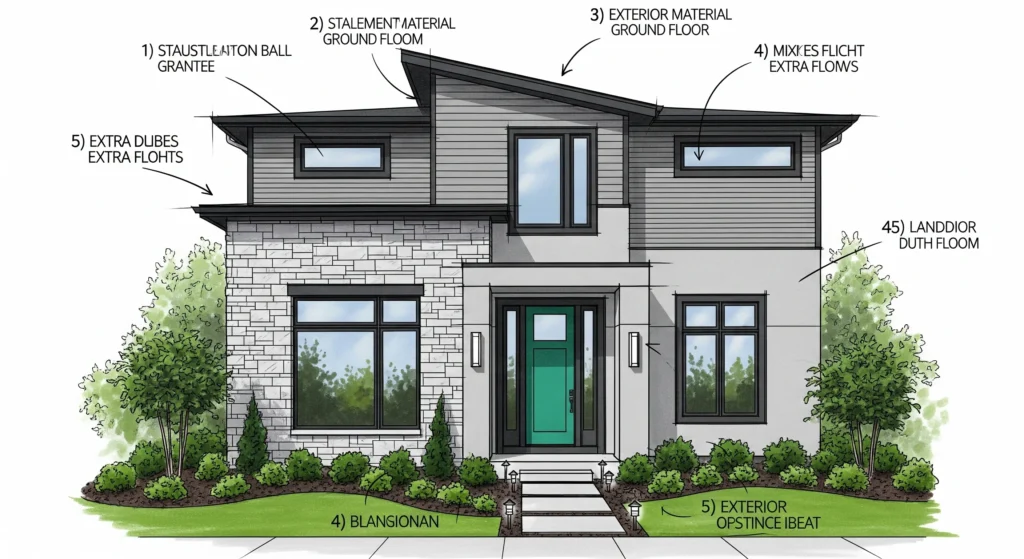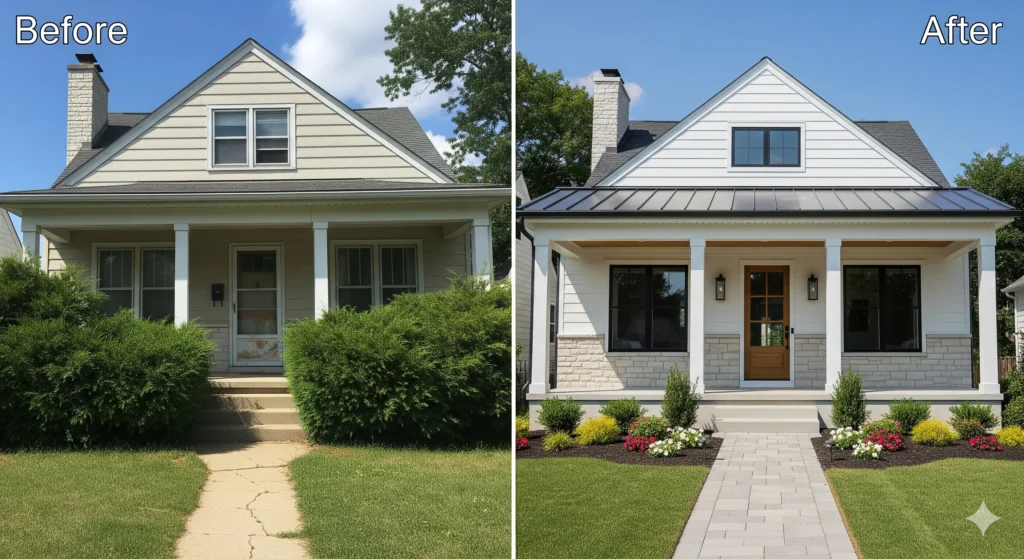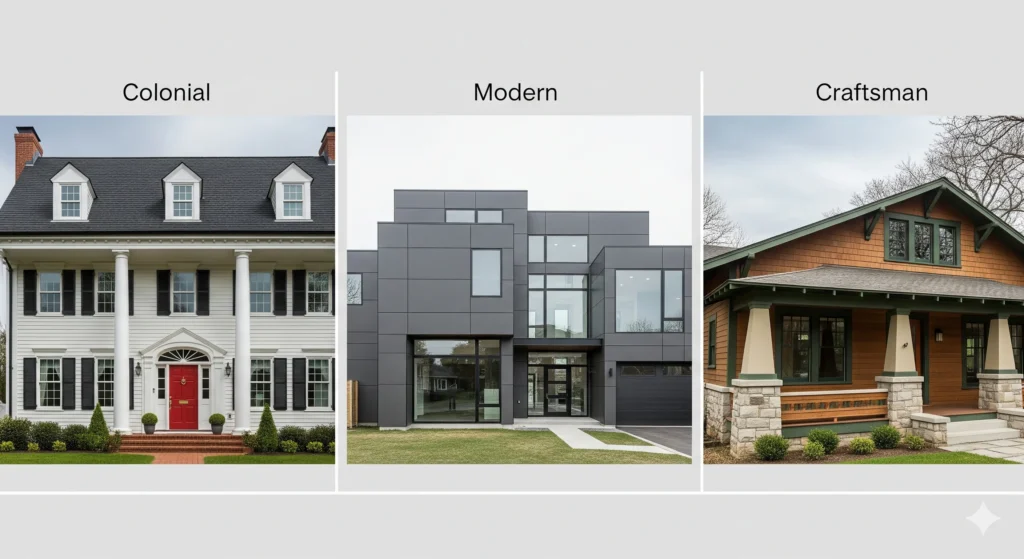Introduction: The Power of Your Home’s First Impression
That feeling of pride and belonging when you pull into your driveway is no accident. It’s the direct result of exceptional front home elevation design. Your home’s facade is its handshake with the world, and perfecting this view is a core goal of residential architecture. More than just aesthetics, a well-executed front home elevation design is a powerful tool for increasing property value and creating a welcoming atmosphere. This guide will provide you with all the inspiration and knowledge you need for your project, whether you’re planning a full front home elevation design renovation or a simple refresh. Let’s explore how to create a stunning first impression.
Chapter 1: Laying the Foundation – Key Considerations Before You Design
Before you dive into choosing materials, it’s crucial to build a solid plan for your front home elevation design. A successful project is built on these key principles.
1.1. Aligning with Your Home’s Architectural Style
The most important rule in any front home elevation design is to respect your home’s inherent architectural DNA. A cohesive look is paramount. For instance, a front home elevation design for a modern building will focus on clean lines, which is very different from the approach for a traditional cottage.
1.2. Climate and Environment: Designing for Your Region
Your front home elevation design isn’t just for show; it’s a protective shell. Designing for your climate ensures your home is beautiful, durable, and efficient. This practical consideration must be a cornerstone of your front home elevation design plans for a truly weather-resistant result.
1.3. Budgeting for Your Project: Smart Investment Tips
Be realistic about your budget for your front home elevation design. A great front home elevation design doesn’t have to be exorbitantly expensive. Smart planning, like focusing on high-impact, low-cost changes, can define your front home elevation design project’s success.
Chapter 2: Exploring Front Elevation Design Styles
This chapter delves into popular architectural styles, providing a wealth of ideas to inform your front home elevation design.
2.1. Traditional and Timeless Styles
These styles draw from history. A traditional front home elevation design might be a perfectly symmetrical Colonial or an ornate Victorian. The goal of this type of front home elevation design is to evoke a sense of classic charm and elegance.
2.2. Modern and Contemporary Styles
A modern front home elevation design prioritizes clean lines, function, and a connection to the outdoors. The focus in this front home elevation design style is on the quality of materials and the interplay of light and shadow.
2.3. Rustic and Regional Styles
Rooted in their location, a rustic front home elevation design uses local materials to feel organically part of the landscape. A modern farmhouse front home elevation design is a hugely popular example of this trend.
The paragraph is specifically addressing design challenges and solutions for smaller homes, which is the exact subject of the linked article on 2 BHK plans.
Chapter 3: Deconstructing the Elevation – Key Design Elements and Ideas
A beautiful front home elevation design is a sum of its parts. Let’s break down the key elements that create a cohesive look.
3.1. The Statement Front Door
Your front door is the centerpiece of your front home elevation design. Choosing the right door—its color, material, and style—is one of the most impactful decisions you will make in your front home elevation design journey.
3.2. Windows and Openings: The Eyes of Your Home
Windows are crucial in any front home elevation design for both light and style. Their placement, proportion, and style can make or break the entire front home elevation design, defining the home’s character.
3.3. Roof Design: The Crowning Glory
The roof is one of the largest visual elements in your front home elevation design. The choice between a pitched or flat roof will dramatically alter the final look of your front home elevation design.
3.4. Wall Finishes and Textures: Creating Depth
Mixing materials is the number-one trick designers use to create a compelling front home elevation design. Using stone veneer or combining different siding types adds critical depth and interest to your front home elevation design.
The Ultimate Guide to Designing Your House Front Elevation
3.5. The Porch and Entryway: A Welcoming Transition
This space bridges the gap between the public street and your private home. A well-designed porch is a hallmark of a welcoming front home elevation design, providing both function and aesthetic appeal.
Chapter 4: The Finishing Touches – Color, Light, and Landscape
The details make the design. This is where your front home elevation design truly comes to life.
4.1. Choosing the Perfect Color Palette
Color is the most powerful tool to unify your front home elevation design. A balanced, three-color scheme is a classic principle of good front home elevation design, ensuring all elements work together harmoniously.

4.2. Lighting Your Home’s Best Features
Exterior lighting serves both aesthetic and safety purposes in your front home elevation design. Strategic lighting is the final layer that makes a good front home elevation design great, highlighting textures and creating ambiance at night.
4.3. Landscaping that Frames, Doesn’t Hide
Your landscaping should complement, not overwhelm, your front home elevation design. The right plants and hardscaping are essential to frame the house and direct the eye toward the entrance, completing the front home elevation design.
Chapter 5: Practical Tips and Common Mistakes to Avoid
5.1. Top Tips for a Successful Design
- Create a Focal Point: Every good front home elevation design has one, whether it’s a stunning front door or a charming porch.
- Sample Everything: View material and paint samples together in natural light before finalizing your front home elevation design plans.
5.2. Mistakes That Can Ruin Your Curb Appeal
- Ignoring Scale and Proportion: An oversized light fixture on a small porch will look awkward and disrupt the balance of your front home elevation design.
- Overcomplicating the Design: Using too many materials or colors creates a chaotic look. A cohesive front home elevation design often relies on a limited, thoughtful palette.
- Before you finalize your plans, it’s wise to visualize the potential outcome. Searching for before and after curb appeal transformations online can provide a realistic expectation of what’s achievable, especially when working with a similar architectural style or budget. Many homeowners are amazed by the dramatic impact of relatively simple changes, proving that you don’t need a colossal budget to achieve a stunning home exterior makeover. This exercise can solidify your choices and fuel your excitement for the project.
- A critical final step in your planning is to create a realistic home exterior renovation budget. It’s easy to get carried away with inspiration, but costs can escalate quickly. Prioritize elements that are structural or difficult to change later, such as roofing, windows, and siding. Decorative elements like affordable exterior light fixtures or landscaping can often be phased in over time. Getting multiple quotes for materials and labor will ensure your vision is grounded in financial reality and help avoid unexpected setbacks.
- For those feeling overwhelmed, remember that achieving a welcoming and cozy cottage facade doesn’t require grand gestures. Often, the most inviting homes use warmth and charm rather than sheer size or opulence. Focus on creating a balanced composition; a perfectly placed bench, a cluster of potted plants, or a charming pathway can be the final touch that makes your house feel like a home. The goal is to create an entryway that feels intentional and inviting, encouraging guests to step inside.
- Finally, always keep long-term maintenance in mind. The best low maintenance landscaping for front yards often involves native plants, perennial shrubs, and mulch to reduce watering and weeding. Similarly, choosing durable materials like fiber-cement siding or composite decking for your porch can save you countless hours of upkeep down the road. A successful design is not only beautiful on day one but continues to be manageable and beautiful for years to come, preserving your investment and your enjoyment.
- The phrase “Biophilic design in modern homes” is a perfect, keyword-rich anchor that clearly describes the linked content.

Conclusion: Building Your Dream Welcome
Designing your front home elevation design is one of the most rewarding projects you can undertake. It’s a chance to express your personality and create a home that feels truly welcoming from the moment you see it. By understanding the core principles, carefully selecting materials, and paying attention to the crucial details, you can achieve a stunning transformation. Your dream front home elevation design is within reach.
Frequently Asked Questions: Front Elevation Design
How can I improve my front elevation on a low budget?
There are several high-impact, low-cost curb appeal ideas you can do yourself. Focus on a simple front elevation makeover by repainting your front door a bold color, updating your exterior light fixtures and house numbers, and adding fresh mulch and strategic landscaping to your front yard. These DIY curb appeal ideas offer a fantastic return without a full renovation.
What are the best materials to use for a modern house exterior?
The best materials for a modern home exterior often include a mix of textures. Think sleek fiber-cement panels, natural wood cladding (like shou sugi ban or cedar), large formats of metal panels, and expansive glass. Using stone veneer for a home exterior accent wall is also a popular way to add warmth and texture to a modern design.
How do I choose a front door color for my home?
Choosing a front door color depends on your home’s style and your personality. Look at your exterior paint colors first. For a classic look, a red or navy blue door is timeless. For a modern pop of color for front door, try a deep emerald green, a bold yellow, or even a glossy black. Always test samples on your door and observe them at different times of day before deciding.
What are some good exterior lighting ideas for a small porch?
Great exterior lighting ideas for a small porch include a single, statement-making pendant light hung over the door or a pair of scaled-down wall sconces on either side of the door. For lighting ideas for the front of house, consider adding low-voltage path lights along your walkway and uplighting in your landscaping to highlight architectural features and trees, which makes the entire facade feel more inviting.
I have a small house. How can I make the front look larger?
Small house front elevation design can be enhanced with a few clever tricks. Use vertical siding (like board and batten) to draw the eye upward, making the house appear taller. Ensure your windows are proportional and not too small. A covered porch or even a simple portico can add depth and dimension, breaking up the flat facade and making the house seem larger.
What is the most timeless front elevation style?
While trends come and go, a classic and elegant front elevation often draws from traditional styles like Colonial or Craftsman. These designs typically feature symmetry, natural materials, and proportional elements that have remained appealing for decades. Choosing neutral exterior paint colors for your main siding with crisp white trim is also a timeless combination that rarely goes out of style.
How can I make my home exterior more weather-resistant?
Creating a weather-resistant home exterior starts with material choice. Fiber-cement siding, brick, and stone veneer are highly durable. For roofing, consider impact-resistant asphalt shingles or metal. Ensure your design includes proper overhangs or eaves to protect the walls from rain, and use quality primer and paint specifically formulated for your climate to protect against sun and moisture damage.
Should I hire a professional for my exterior design?
For a full home exterior renovation, especially involving structural changes, consulting with an architect or designer is highly recommended. They can help with a cohesive house facade design and navigate permits. However, for many DIY curb appeal projects like painting, landscaping, and updating fixtures, a confident homeowner can achieve fantastic results with careful planning and research.
